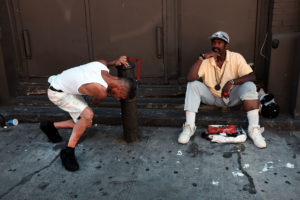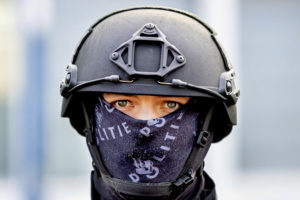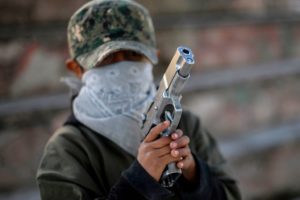In the hills of Mexico City’s luxurious Lomas suburb, close to an embassy and UN offices, is a white pillared mansion that was the site of the world’s biggest ever drug cash bust. In 2007, Mexican federal agents stormed through its ornamental gates to discover a mountain of $205 million in bills, along with pesos, Euros and Hong Kong dollars. It did not, however, belong to one of Mexico’s scarred and bloodthirsty drug lords from the mountains; instead it was the property of the suited Chinese-born businessman Zhenli Ye Gon.
Ye Gon was making his fortune, say US and Mexican prosecutors, by importing the flu medicine pseudoephedrine from Chinese labs and selling it to Mexican gangsters who cooked it into crystal meth to traffic to the United States. A fan of high-stakes poker, Ye Gon was then jetting to Las Vegas, where he lost $125 million at tables (a casino was later ordered to hand over much of this to the US government) and bought a million-dollar home for a casino hostess. After a lengthy legal battle, Ye Gon was extradited back here to Mexico, where he sits in a high-security prison on drugs, organised crime, money laundering, and weapons charges.
At the time, when I covered the story, Ye Gon appeared to be a passing novelty. Importing chemicals from China contrasted with the cocaine and heroin trade I was investigating, in which you can go to the mountains and witness the peasant farmers harvest coca leaves and opium poppies. It’s apparent now, though, that Ye Gon was a pioneer, and that Mexican cartels have followed his lead to reshape their entire industry — with perilous consequences for Americans.
Since that record bust, Mexican traffickers have gradually shifted the core of their business from plant-based drugs to synthetic drugs — those created using man-made chemicals. These include meth and illegally-made fentanyl as well as others, such as ketamine. Synthetic drugs are cheaper to produce and more lethal, with fentanyl many times more powerful than heroin. To churn out these synthetics, cartels followed Ye Gon’s lead to forge an unholy alliance with shady elements of the Asian chemical industry.
The scales gradually tilted until 2018, when US agents on the border seized more crystal meth than cocaine (both considered “uppers” and party drugs), and 2021, when they also seized more fentanyl than heroin (both considered “downers”). The trend has accelerated in 2022, with US agents nabbing 14,000 pounds of fentanyl, which was seven times the amount of heroin, and 175,000 pounds of meth, two-and-a-half times the amount of cocaine.
Marijuana was once a big cash crop for Mexican traffickers, but border seizures have plummeted since 2012, when US states began legalising recreational weed. Further south, Colombia is still producing enormous amounts of cocaine, but much is now going to the booming European market. Meanwhile, the biggest shipments to, and profits from, the United States are in synthetics. This paradigm shift has transformed the logistics of Mexican drug trafficking.
Traditionally, drug trafficking relied on plantations of poppies and coca leaves, which are vulnerable to aerial crop spraying. Today, the mass production of synthetic drugs involves two behemoths of globalisation: supply chains of cargo ships, and the pharmaceutical industry. Pacific cities such as Manzanillo, Mexico’s biggest container port, have become bloody trafficking hubs. Pill mills can be anywhere, from quiet Mexican suburbs to right on the border itself.
The cartel shift to synthetics coincides closely with the soaring rise in US drug deaths. Back in 2007, about 27,000 Americans lost their lives in overdoses. By 2021, the number had quadrupled to 107,000 deaths. The majority, 71,000, involved fentanyl or other synthetic opioids. The second highest, 32,000, involved “psychostimulants” including meth. Traffickers are also mixing fentanyl into cocaine and heroin, causing more deaths with those. The rise in overdoses is especially sharp over the last five years, just as busts of fentanyl on the border have soared.
But beyond the stats is the human pain. Most of the victims are in the prime of their lives and some are teenagers. Millions of parents, siblings, children, and friends bear the loss.
There are various forces behind the US overdose epidemic. Pharmaceutical giants dished out too many legal opioids that fuelled addiction, as courts continue to hear. Shutting down industries in the Rust Belt drove workers to despair, and the pandemic and lockdown were terrible for mental health. But it is hard to deny that changes in the supply of illegal drugs — from cocaine and heroin to synthetic meth and fentanyl — are a major factor behind the ballooning death toll.
Like everything in American life, the overdose epidemic gets dragged into partisan politics. Republicans have sought to take a hard line, lobbying the White House to classify fentanyl as a weapon of mass destruction and Mexican cartels as terrorist groups. In their midterm attack ads, Republican candidates tied fentanyl deaths to illegal immigration. Democrats, meanwhile, have pushed hardest for “harm reduction” programmes, especially in deep-blue cities like San Francisco. But the level of open drug abuse there has drawn fire from both Republicans and moderate Democrats.
After covering the human catastrophe of narco violence here in Mexico for two decades, I have mixed feelings about the latest political row. I have long been a critic of the War on Drugs, which has failed to stop the drug trade while creating a huge black market for ultraviolent cartels. When US states began legalising marijuana, I celebrated it, thinking that the cartels and drug violence could slowly become a thing of the past.
But the rise of synthetics and the sheer level of overdose deaths have rattled my thinking. It is evident that Mexican traffickers, who work with corrupt officials here, are indeed pumping ever more perilous drugs northward. When cartels mainly moved cocaine and cannabis there was an argument, at least, that they were providing Americans with products they demanded. But with the perilous fentanyl, which some people take unwittingly, there is validity to the claim they are flooding poison over the border. The question remains, however, as to what can be done about it.
In Manzanillo, I sit and watch the vast container ships come into the bay from across the globe and line up to unload their cargo. Last year, the port handled more than 3 million TEU’s (20-foot container units) — a vast amount of cargo for synthetics and their precursors to be hidden in. In a restaurant in the port, I meet up with the owner of a freight company who brings goods in from China. Working in the port for decades, he says smuggling has always been rife but has evolved over time. Today, Mexico’s two most powerful mafias, the Sinaloa Cartel and Jalisco New Generation Cartel, operate there and are always looking for shippers to move their products. “This is the gateway to China and all of Asia,” he says. “They have to be here to get access to chemicals.”
Opioids or precursors can be hidden under a false bill of lading and disguised as a legitimate chemical, he explains. Customs inspectors have to bust open a container and run a test, and while they are doing that, other loads can get through. It can also be hard to keep up with all the different substances. The International Narcotics Control Board lists hundreds of precursors for synthetic drugs, and they are likely scratching the surface. Scientific papers say there are more than 1,400 variants of fentanyl, and that “every year new fentanyl analog compounds, or fentanyls, appear”.
Smugglers also have another technique, the shipper explains, which they call “remoras” or suckerfish, in which they bring in the contraband alongside legitimate cargo. Before the ship gets into port, the contraband is thrown over the side and taken ashore in small boats. It would, therefore, be difficult to stop the chemicals even if Mexican officials were all honest — which they are not. The shipper explains that intermediaries take bribes and deal with customs so that containers can pass straight through. “I can’t see this changing,” he said. “Only a dictatorship or invasion would stop this.”
President Andrés Manuel López Obrador, known as AMLO, claims to fight corruption, and over the last two years he has put elite marine military units in charge of the ports to clamp down on trafficking. “It is translating to more security, less contraband, more decommissions of drugs, above all fentanyl and chemical drugs,” AMLO said in November visiting Manzanillo. “It used to be silver or lead,” he went on, referring to the silver of a bribe or the lead of a bullet. “Now this has changed.”
However, the quantity of drugs being seized on the US border signal that fentanyl and meth are still coming through Mexico in vast quantities. Furthermore, AMLO’s position on cartels and crime is muddled. On the one hand, he has boosted the power of the military, created a new National Guard, and kept soldiers on the streets. On the other hand, he has talked of the need to avoid fighting cartels, and to have “hugs not bullets”.
AMLO’s call for peace is understandable considering the carnage in Mexico. Since President Felipe Calderón launched a military crackdown on cartels in 2006, there have been firefights reminiscent of civil wars, more than 300,000 murders, mass graves, and thousands of disappearances. But in practice, “hugs not bullets” has meant allowing some gangsters to act with impunity. In 2019, after soldiers arrested Ovidio Guzmán, the son of kingpin “El Chapo”, on an indictment for trafficking drugs including crystal meth, hundreds of gunmen took to the streets of the city of Culiacán. In response, AMLO ordered Guzmán’s release. By bowing to cartel intimidation, AMLO has raised the spectre of a country that is militarised but where powerful gangsters still flout the law.
Washington has also put pressure on China to stop the chemicals at the source. In 2019, China classified all variants of fentanyl as controlled substances, fulfilling a promise to President Donald J. Trump. However, a US congressional advisory group concluded that Chinese chemists were getting round the ban. “Chinese traffickers are using various strategies to circumvent new regulations, including focusing on chemical precursors, relocating some manufacturing to India, rerouting precursor shipments through third countries, and leveraging marketing schemes to avoid detection,” says the report from 2021 by the US-China Economic and Security Review Commission.
But given China denies its responsibility for the drug epidemic, what can be done about it? If Beijing really clamped down, it could probably reduce the supply in the short term. But there are other countries where precursors could be made. Moreover, as former DEA agent Leo Silva tells me, the cartels are looking to take their drug production to the next step. “These guys are now recruiting chemistry professors from universities so they can actually produce fentanyl in labs,” he says. “Their goal is to create the precursors in Mexico so they can also stop getting the precursors from China and dealing with them… So they can produce more, and keep more profits.”
***
Order your copy of UnHerd’s first print edition here.
Disclaimer
Some of the posts we share are controversial and we do not necessarily agree with them in the whole extend. Sometimes we agree with the content or part of it but we do not agree with the narration or language. Nevertheless we find them somehow interesting, valuable and/or informative or we share them, because we strongly believe in freedom of speech, free press and journalism. We strongly encourage you to have a critical approach to all the content, do your own research and analysis to build your own opinion.
We would be glad to have your feedback.
Source: UnHerd Read the original article here: https://unherd.com/







